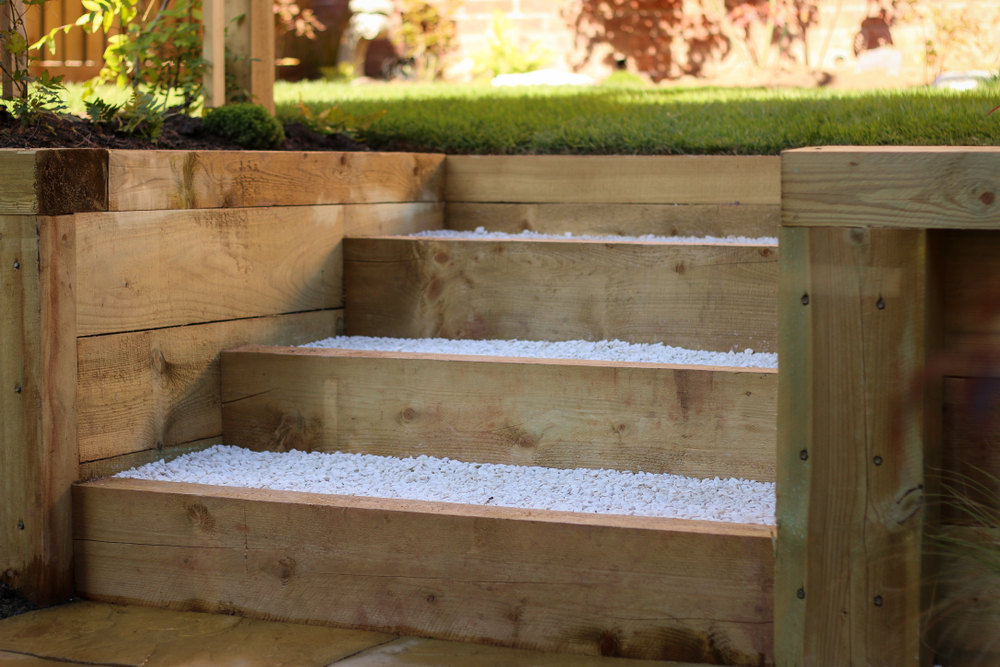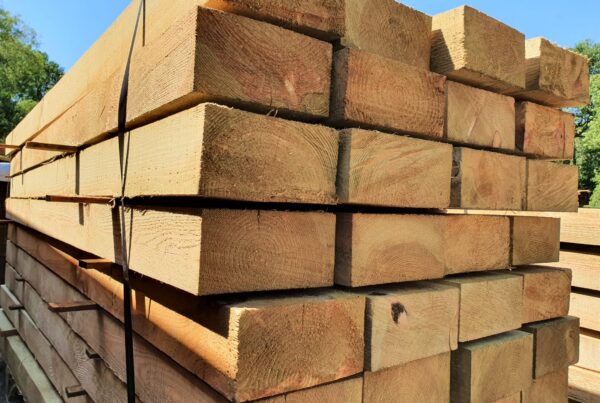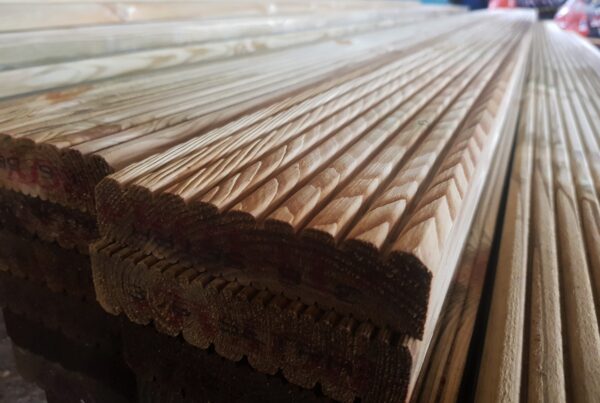Beginning an outdoor project is an exciting prospect, whether you’re planning new decking, a decorative garden fence or a bespoke pergola. At the heart of any project’s success is the selection of the right timber. The right choice will enhance the aesthetic appeal of your outdoor space and ensure durability against the elements. At Timber Pro, we pride ourselves on offering high-quality timber products at competitive prices. Our extensive range caters to various outdoor projects, ensuring you find the perfect match for your needs.
In this comprehensive guide, we’ll explore the five key factors to consider when selecting timber for outdoor projects. By understanding these key aspects, you’ll be well-equipped to make informed decisions, ensuring your outdoor structures stand the test of time and seamlessly blend with your landscape. Contact us today for more information and get started with your next project!
5 Key Factors to Consider When Selecting Timber for Outdoor Projects
Choosing the right timber for outdoor projects involves more than just picking a type of timber that looks good. It’s about understanding how different woods react to external conditions, their unique properties, and how they align with your project’s requirements. Here are 5 important factors to consider when selecting timber for your outdoor project…
- Durability & Resistance to Decay
Outdoor structures are continuously exposed to varying weather conditions, from intense sunlight to heavy rainfall. Therefore, selecting timber with natural durability and resistance to decay is essential.
- Natural Durability
Certain types of timber are inherently resistant to fungi, insects and other types of decay. Hardwoods like oak and teak are renowned for their longevity, making them excellent choices for outdoor projects.
- Pressure Treatment
Softwoods, such as pine, can be enhanced through pressure treatment. This process involves infusing preservatives deep into the wood fibres, enhancing their resistance to decay and extending their lifespan.
- Maintenance Considerations
Even with durable timber, regular maintenance, including sealing and staining, can further protect the wood and maintain its appearance over time.
Choosing the right timber can significantly enhance the longevity of outdoor structures. By combining natural durability, protective treatments and regular maintenance, you can ensure your timber projects remain strong, resilient, and visually appealing for years to come.
- Moisture Content & Movement
Timber is a natural material that responds to environmental humidity, expanding when moist and contracting as it dries. Understanding and managing this movement is crucial to prevent structural issues.
- Seasoned Timber
Choose timber that has been properly dried or seasoned. Seasoned timber has a balanced moisture content, reducing the risk of excessive movement once installed.
- Moisture Barrier
Incorporating moisture barriers or damp-proof membranes can protect timber components from ground moisture, especially for structures like decking or garden sleepers.
- Design Considerations
Allow for natural expansion and contraction in your design. For instance, leaving appropriate gaps between decking boards can accommodate timber movement and prevent warping.
By carefully selecting and preparing timber, you can minimise the risks associated with moisture-related movement. Thoughtful design and protective measures will help maintain the stability and longevity of your outdoor structures.
- Strength & Structural Integrity
The structural demands of your project will determine the strength requirements of the timber used. Ensuring the chosen wood can withstand applied loads and stresses is vital for safety and longevity.
- Grading
Timber is graded based on its strength and suitability for structural applications. For example, C24 graded timber offers superior strength, making it ideal for load-bearing structures.
- Species Selection
Different timber species offer varying strength characteristics. Hardwoods generally provide higher strength but can be more challenging to work with compared to softwoods.
- Application-Specific Choices
For structural elements like beams or joists, prioritise strength and load-bearing capacity. In contrast, for non-structural components like cladding, focus on durability and aesthetic appeal.
Selecting the right timber with adequate strength ensures the safety and longevity of your structure. By considering grading, species and application-specific needs, you can create a durable and reliable outdoor project.
- Aesthetic Appeal & Finish
The visual impact of your outdoor project significantly depends on the timber’s appearance, including its grain pattern, colour, and how it weathers over time.
- Grain & Texture
Woods like cedar and redwood offer distinct grain patterns that add character to structures. Consider how the timber’s texture aligns with your design vision.
- Colour
Timber ranges from light hues of pine to deep tones of mahogany. Keep in mind that exposure to sunlight can alter the wood’s colour over time, with some species developing a desirable patina.
- Finishing Options
Applying stains, oils, or paints can enhance the timber’s appearance and provide additional protection. Regular reapplication may be necessary to maintain the desired look and safeguard the wood.
Choosing timber with the right aesthetic qualities ensures your outdoor project complements its surroundings. With proper finishing and maintenance, you can preserve its beauty while enhancing durability over time.
- Environmental Impact & Sustainability
With growing environmental awareness, selecting timber that aligns with sustainable practices is both responsible and often a project requirement. At Timber Pro, we are committed to sustainability, offering FSC-certified timbers that come from responsibly managed forests. By choosing these timbers, you’re supporting the environment and ensuring that your project is both durable and eco-friendly. Sustainable timber choices benefit the planet and guarantee that your outdoor space will remain beautiful.
By carefully evaluating these factors, you can select timber that not only meets the functional and aesthetic requirements of your project but also contributes to environmental sustainability. Get in touch with Timber Pro today for more information!
Why use timber for your outdoor project?
- Natural Durability & Strength
Many timber species offer excellent resistance to weathering, decay and pests, making them long-lasting choices for outdoor structures.
- Aesthetic Appeal
Timber’s natural grain patterns and warm tones create a visually appealing, timeless look that blends seamlessly with outdoor environments.
- Sustainability
Responsibly sourced timber is a renewable, eco-friendly material that has a lower carbon footprint compared to alternatives.
- Versatility & Workability
Timber is easy to cut, shape and join, allowing for flexibility in design and customisation for various outdoor applications like decking, pergolas, furniture and more!
- Thermal Comfort
Unlike metal or concrete, timber does not absorb excessive heat, making it comfortable to touch and walk on even in hot weather.
How can Timber Pro help?
At Timber Pro, we understand that the success of your outdoor project hinges on the quality and suitability of the materials used. Our extensive range of timber products is designed to cater to diverse project needs, ensuring durability, aesthetic appeal, and sustainability.
Fencing
Our fencing products are crafted to withstand the elements while providing privacy and enhancing the beauty of your outdoor space. We offer a variety of styles and finishes to complement any garden design. View our full range here…
Decking
Transform your outdoor area with our premium decking solutions. Available in various timber species, our decking boards are selected for their strength and resistance to decay, ensuring a long-lasting and attractive addition to your home. View our full range here…
Sleepers
Ideal for landscaping projects, our timber sleepers are versatile and durable. Whether you’re constructing raised beds, retaining walls, or garden steps, our sleepers provide a robust foundation with a rustic charm. View our full range here…
Sheet Material
For structural applications and bespoke projects, our range of sheet materials, including hardwood plywood and OSB 3 boards, offers flexibility and strength. These materials are suitable for various outdoor constructions, providing a reliable base for your designs. View our full range here…
Structural Timber
Our structural timber selection includes C24 tanalised carcassing, CLS timbers, and roof battens. These products are graded for strength and treated for longevity, making them ideal for load-bearing applications in outdoor structures. View our full range here…
Cladding
Enhance the exterior of your home or garden structure with our high-quality cladding options. Our range includes softwood and hardwood cladding solutions, designed to provide both aesthetic appeal and weather protection. View our full range here…
By choosing Timber Pro, you are guaranteed superior quality timber products, expert advice, and competitive pricing. We are committed to helping you achieve your outdoor project goals with ease and confidence. Get in touch with us today for more information!
Your Project: Choosing the Right Timber Matters
Selecting the right timber is an essential decision that impacts the longevity, aesthetics and sustainability of your outdoor projects. By considering factors such as durability, moisture content, structural integrity, aesthetics, and environmental impact, you can ensure that your project stands the test of time while maintaining its visual appeal.
At Timber Pro, we are dedicated to providing high-quality, sustainable timber solutions that cater to various outdoor applications. Whether you need fencing, decking, sleepers, sheet material, structural timber, or cladding, we have the perfect products to meet your needs. Explore our range today and take the first step toward a successful outdoor project.
FAQs
What is the best type of timber for outdoor use?
The best timber for outdoor use includes hardwoods like oak and teak, as well as pressure-treated softwoods like pine and spruce, which offer durability and resistance to decay.
How do I protect outdoor timber from weather damage?
You can protect outdoor timber by using weatherproof stains, oils, or sealants. Regular maintenance, such as reapplying finishes and keeping timber clean, also helps prolong its lifespan.
What is pressure-treated timber, and why is it beneficial?
Pressure-treated timber has undergone a process where preservatives are forced deep into the wood, making it more resistant to rot, fungi, and insect damage, increasing its longevity for outdoor use.
How can I maintain my timber fence?
Regular maintenance involves cleaning your fence, applying a treatment or stain every few years, and checking for signs of damage such as warping or rot. Treated softwoods typically need more maintenance than hardwoods.
What is the difference between treated and untreated timber?
Treated timber has been infused with preservatives to protect it from rot, insects, and decay. Untreated timber lacks these treatments and requires regular maintenance to prevent weather damage.
How can I prevent timber from warping or cracking outdoors?
Using seasoned or kiln-dried timber, ensuring proper ventilation, and applying protective coatings can help prevent warping or cracking. Additionally, designing with expansion gaps accommodates natural movement.
Is sustainable timber better for outdoor projects?
Yes, sustainable timber is an environmentally friendly choice that helps preserve forests. Look for FSC-certified timber to ensure responsible sourcing without compromising quality.
What is the difference between hardwood and softwood for outdoor use?
Hardwoods, like oak and teak, tend to be more durable and resistant to decay, whereas softwoods, like pine and cedar, are lighter, easier to work with, and can be pressure-treated for longevity.
Does timber colour change over time when used outdoors?
Yes, many timbers change colour over time due to UV exposure and weathering. For example, teak turns a silvery-grey patina. Applying UV-protective finishes can help maintain the original colour.
Can I use untreated timber for outdoor projects?
Untreated timber is not recommended for outdoor projects as it is more susceptible to decay and insect infestation. Always choose naturally durable or treated timber for extended lifespan.
How often should I maintain my outdoor timber structures?
Maintenance frequency depends on the timber type and environmental conditions. Generally, it is advisable to inspect and treat timber annually to ensure long-lasting performance.
Now that you understand the key factors in selecting timber for outdoor projects, it’s time to put your knowledge into action. Whether you’re planning a new deck, a fence, or any other timber-based outdoor structure, Timber Pro is here to help. Browse our extensive range of high-quality timber products today and let us help you bring your outdoor project to life.



